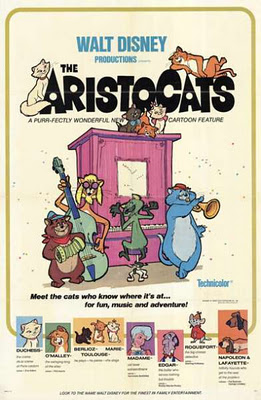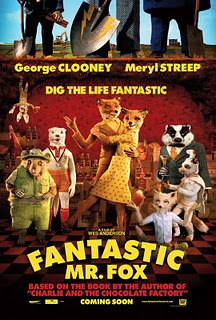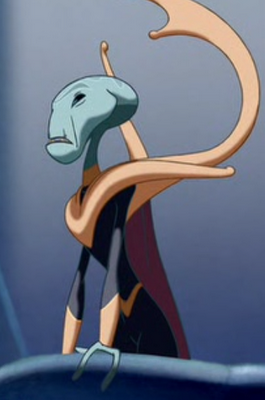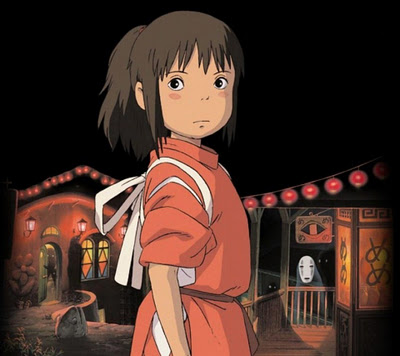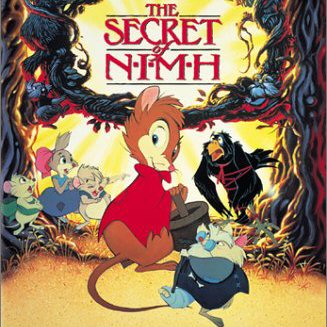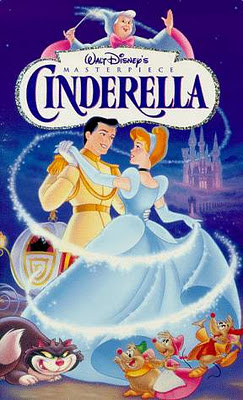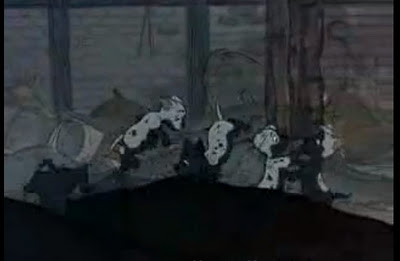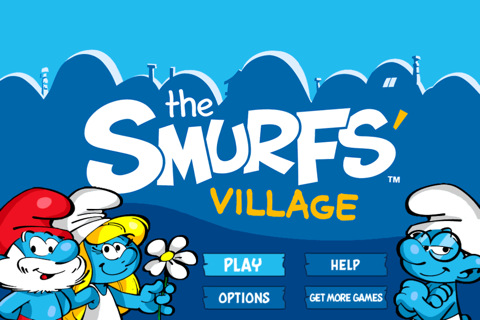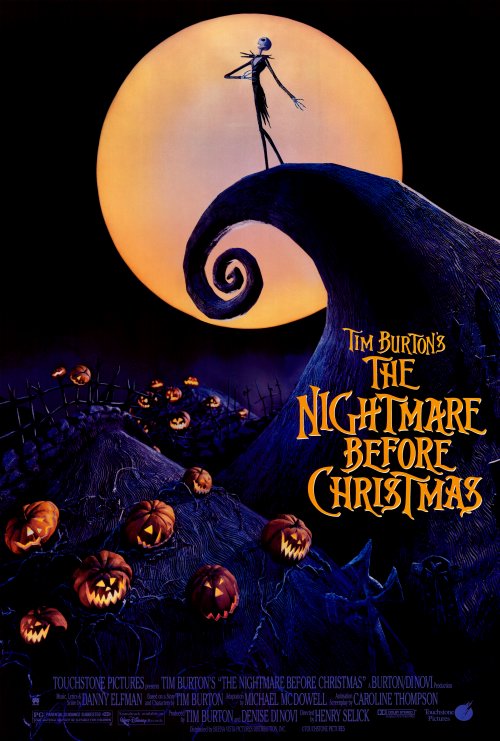Emily Belanger currently lives in Utah, where she’s completing an MFA in creative writing. When she isn’t writing fiction or teaching, she co-edits Not Another Wave, a feminist blog with an inclusive angle, and writes for Go Girl Magazine, a travel magazine for and by women. She’s originally from rural New Hampshire and misses the humidity very much.
Author: Bitch Flicks
Animated Children’s Films: Anthropomorphism and Sexism in Disney’s The Aristocats*
Animated Children’s Films: From the Archive: Fantastic Mr. Fox
Note to Wes: if your one female character (wife + mother) is supposed to be a professional artist, could you at least show her working during the DAY in her STUDIO, not cooking all day and painting outside at night with her kid and husband sitting around her?It’s disappointing that this film incorporates Dahl’s lack of interest in women (that veers close to misogyny). I guess it’s not that much different from other Wes Anderson films that way…but with a little more imagination it could have been so much better.
1) In the original, Mrs. Fox was complicit all along. 2) Mr. Fox never went on the wagon. 3) Mr. and Mrs. Fox had four cubs, not one little nutcase, and Dahl made no mention of a yoga-bending super-nephew. 4) I’m pretty sure the point of the story wasn’t Mr. Fox’s flagging self-esteem or his strained relationship with his son. But this is cinema in the time of Oprah, when Reductio ad navelgazing is the inevitable narrative arc.
Animated Children’s Films: Lilo & Stitch
This is a guest review by Sarah Kaplan.
 |
| The Grand Councilwoman |
 |
| Jumba and Pleakley |
 |
| Lilo |
Life isn’t easy for Lilo, whose parents are dead, leaving her sister as her legal guardian. Lilo describes her family as “broken,” and it’s clearly a difficult situation for both sisters. Lilo is aware that her family isn’t normal, but she still considers the concept of “ohana,” family, very important. It’s a central theme in the movie.
Lilo also faces the cruelty of female cliques, despite her young age. In the scene pictured in the screenshot above, other girls her age refuse to play dolls with her. (In a nice touch, the other girls’ dolls, while Barbie-shaped, match their different hair colors. Two of these girls, like Lilo, are native Hawaiians.) To be fair, she had bitten one of them not long before. This movie doesn’t whitewash its protagonists, and it isn’t afraid to show children as cruel and violent at times.
 |
| Nani |
Lilo & Stitch is a wonderful, thoroughly feminist children’s movie, and one of my personal favorite movies of all time. It’s funny, thoughtful, and a surprising treat from Disney.
—–
Animated Children’s Films: Spirited Away
—–
Animated Children’s Films: The Secret of N.I.M.H.
A rose bush inhabited by genetically modified rats who become murderous sounds more like a horror movie than a children’s story, but that is just one of the ways The Secret of N.I.H.M. breaks the mold.
The plow has come early to the Fitzgibbons farm, a frightening thought for all the animals that live in the fields. Mr. and Mrs. Fitzgibbons also happen to have a band of rats living on their farm who were part of an experiment from the National Institute of Mental Health that made them “intelligent.” As Nicodemus, head intelligent rat (who is also a little magic?) tells the audience eerily: “We found out, we could reeead.”
So no, the The Secret of N.I.M.H. is not free from gender stereotypes or tired portrayals of women. But The Secret of N.I.M.H. has one thing that many children’s films don’t have, a female protagonist. A main character who is a hero because of her strong will, intelligence, and heart (not accidentally a hero because of her knowledge of beauty products a la Elle Woods).
Mrs. Brisby is a single mother known only by her husband’s name in the film. And time and again that name gets her help from the other characters in the movie who remember her husband, Jonathan, fondly. However, it is not just the name that gets Mrs. Brisby’s tiny house moved out of the way of the plow and keeps her children from impeding doom. She shows fear and dread, she takes risks and shakes and cries. Yet she presses on. She is not a female hero full of bravado and stereotypically male characteristics. She is a mother who will face even a large owl (owls eat mice) to find out how to save her family.
Brisby also has to face an almost completely male world. Aside from the shrew and her daughters, there are no other prominent female characters. There are however many males, who do their best to either help or hurt her.
- No fur boobs: the tendency to sexualize animals’ bodies to make them look more human might have its place in comic books (or not), but luckily the 1980s illustrators of Secret did little to feminize Mrs. Brisby. She has long lashes and a small red cape, but no busting chest, long legs, or human-shaped butt.
- She can read too!: She didn’t get experimented on and yet she can read. She was taught. Amazingly, all those male rats have used their smarts to steal electricity. Jonathan Brisby taught his wife to read. And guess what, it worked and did not require a big painful shot.
- Her ultimate goal has nothing to do with finding a husband: At no point in the film is her lack of a husband an actual hurdle. Sure, Mrs. Brisby misses Jonathan, but the film takes for granted that she is making it alone in this crazy rat-filled world. And, as I already pointed out, she doesn’t marry Justin!
—–
Animated Children’s Films: Why I’m Excited About Pixar’s ‘Brave’ & Its Kick-Ass Female Protagonist…Even If She Is Another Princess
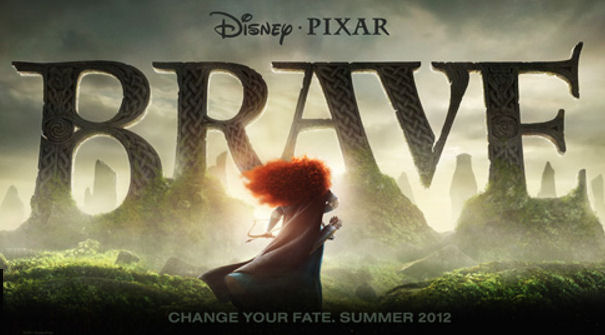 |
| Disney Pixar’s Brave, in theatres June 2012 |
“A lady enjoys elegant pursuits.”
“I want my freedom.”
“Sounds promising, though I cannot help but feel, after waiting patiently (and sometimes not so patiently) through twelve genre-busting films about male robots, male superheroes, male cowboys, male rats, male cars, male bugs, male fish, and a small male mailman, that it would have been nice if the movie was not about a princess, even a kick-ass one. Honestly, is that too much to ask?”
Animated Children’s Films: Cinderella
 |
| Cinderella (1950) |
Animated Children’s Films: James and the Giant Peach
James: “The man said marvelous things would happen!”Glowworm: “Did you say marvelous pigs in satin?”
Animated Children’s Films: 101 Dalmatians!
This is a guest post from Sade Nickels.
- Cruella is very kind to Anita and very cruel to her husband Roger. Is it because she is in love with Anita?
- Cruella’s henchman (or Baduns), Jasper and Horace, are both dudes and always together. They are often thwarted in a very slapstick manner. Almost always all the time they end up in some sort of sexually compromising position. See for yourself (note the pink underwear).
Race and Class
- First! There are SO many racial and class problems in this movie. My MAIN issue are the race ones. The first being that Pongo, the dad dalmation, is only attracted to another dalmation. Hmmm…
- Second! When the dogs are running back to London and they are escaping Cruella, they meet up with a labrador who gets them a ride to the city. In order to sneak onto the van the dogs get covered in soot to look like labs (as Pongo says, “That’s the stuff the blacker the better!”). Dog blackface?
- Third! When the dogs arrive back home Rodger (the human dad character) starts singing about how they (the humans) will start a Dalmatian Plantation. Ok, so I know the words rhyme and all, but it is still in poor taste. Oh great, there is a song about it.
Whew! Well, that is all folks. Would LOVE to read your comments.
—–
Animated Children’s Films: Is Smurfette Giving it Away? Let Your Kids Decide
Animated Children’s Films: Nightmare Revisited
 |
| The Nightmare Before Christmas (1993) |
 |
| Shock |
 |
| Sally |
Jessica Critcher loves to write about feminism and gender issues, and she is a regular contributor to Gender Focus. While she loves living in Boston, she often misses Honolulu, where she earned her bachelor’s degree in English (and forgot that there was such a thing as snow).
